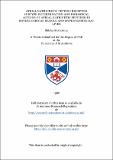Atrial natriuretic peptide receptor subtype determination and biological actions of atrial natriuetic peptided in bovine cardiac muscle and hypertensive rat liver
Abstract
Atrial natriuretic peptide (ANP) has previously been shown to bind to specific ANP receptors and increase intracellular cGMP levels in purified rat cardiac sarcolemmal membranes. Experiments described in this thesis were performed to investigate the binding characteristics of ANP in bovine ventricular sarcolemmal membranes and in plasma membranes isolated from the liver of hypertension-resistant and hypertension-sensitive Dahl rats fed on two dietary salt regimes one of 0.8% NaCl and the other 8% NaCl. Additional experiments utilising ANP analogues in radio-receptor assays and radio-receptor crosslinking assays were performed to determine the precise nature of the ANP receptor population present in these membrane preparations. In bovine ventricular cardiac sarcolemmal membranes, ANP bound specifically to one class of ANP receptor with a Kd of approximately 44 pM and a Bmax of approximately 49 fmol/mg protein. ANP produced a 1.8-fold stimulation of manganese-dependent guanylate cyclase activity with an EC50 value of approximately 1 nM. Receptor binding using the des-ANP analogue indicated the predominant presence of the ANP-B receptor subtype. Radioreceptor crosslinking experiments did not entirely agree with these experiments. Radio-receptor crosslinking indicated the presence of two ANP receptors one of 60 kDa and one of 120 kDa, equivalent to the molecular weights of ANP receptors found in other tissues. Collectively these experiments indicate that bovine ventricular sarcolemmal membranes possess ANP receptors, at least a proportion of which are coupled to guanylate cyclase (ANP-B receptors). In plasma membranes from the liver of Dahl-Resistant (Dahl-R) and Dahl-Sensitive (Dahl-S) rats, ANP bound specifically to one class of ANP receptor with Kd values ranging from 245 to 288 pM and Bmax values ranging from 104 to 217 fmol/mg protein. ANP produced a 3.8 to 6.15-fold stimulation of manganese-dependent guanylate cyclase activity with an EC50 values ranging from 2.3 to 7.4 nM, dependent on the strain of Dahl rat and the dietary salt regime used. In liver membranes isolated from rats sensitive to salt-induced hypertension results indicated increases in Bmax with no change in Kd for ANP binding to receptors and higher basal and ANP-stimulated guanylate cyclase levels. Receptor binding using the des-ANP analogue indicated the presence of 13-33% ANP-C receptors with a majority of ANP-B receptors in plasma membranes isolated from the liver of Dahl-R and Dahl-S rats. However, radio-receptor crosslinking experiments were unable to support these results. Collectively these experiments indicate that in plasma membranes isolated from the liver of Dahl-R and Dahl-S rats possess ANP receptors, at least a majority of which are coupled to guanylate cyclase (ANP-B receptors) and that sensitivity to hypertension induced by a high salt dietary regime increases the density of ANP receptors coupled to guanylate cyclase.
Type
Thesis, PhD Doctor of Philosophy
Collections
Items in the St Andrews Research Repository are protected by copyright, with all rights reserved, unless otherwise indicated.

